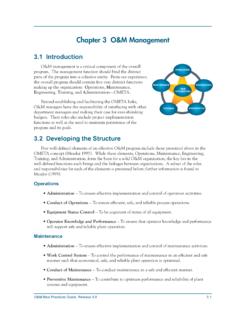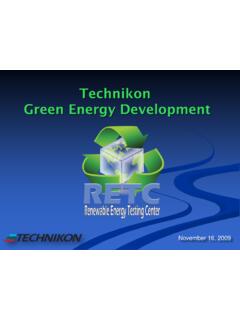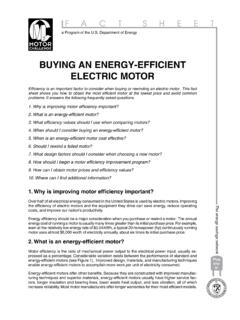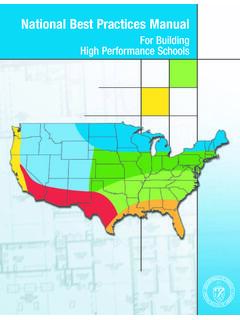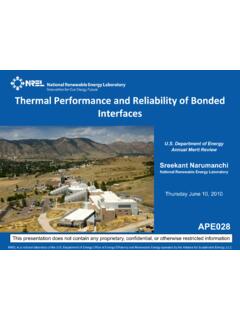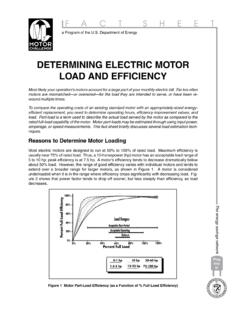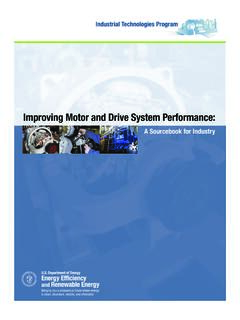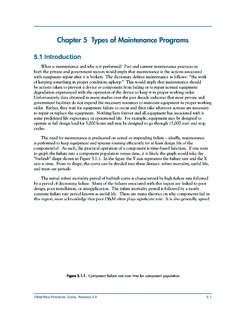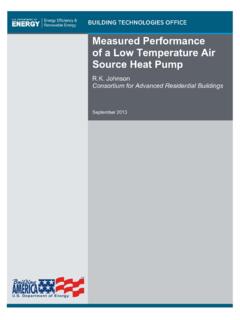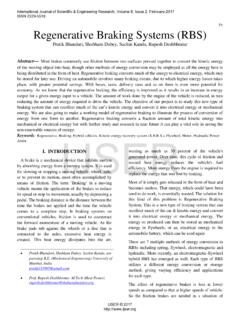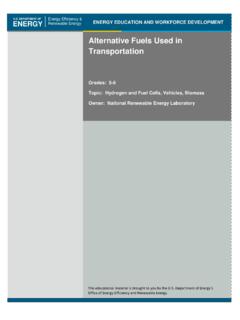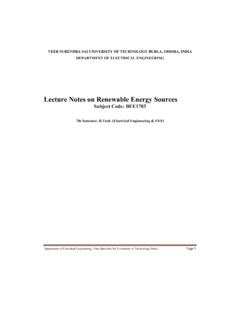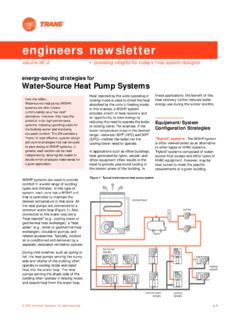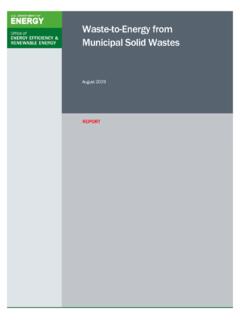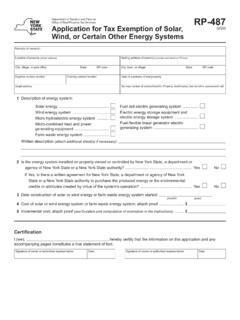Transcription of Improving Compressed Air System Performance - Energy
1 Department of EnergyEnergy Efficiency and Renewable EnergyOne in a series ofindustrial energyefficiency sourcebooksa sourcebook for industryBringing you a prosperous future where Energy is clean,abundant, reliable, and affordableImprovingCompressed AirSystem PerformanceAcknowledgmentsImproving Compressed Air System Performance : A Sourcebook for Industryis a cooperative effort of the Department of Energy s Office of Energy Efficiency and Renewable Energy (EERE) BestPractices and theCompressed Air Challenge . EERE originally undertook this project as part of a series of sourcebook publicationson industrial systems. Other topics in this series include: pump systems; fan systems; motors; process heating; andsteam systems.
2 As work on the first edition progressed, the Compressed Air Challenge was formed, bringingtogether the extraordinary combined talents of Compressed air System auditors, trade associations, equipmentmanufacturers and distributors, utilities, and government agencies in a collaborative effort to improve the Performance of industrial Compressed air systems. The two programs joined forces in preparing this secondedition. For more information about EERE and the Compressed Air Challenge , see Section 3: Where to Find Compressed Air Challenge , EERE s BestPractice Program, Lawrence Berkeley National Laboratory, andResource Dynamics Corporation wish to thank the staff at the many organizations who so generously assistedin the collection of data for this sourcebook.
3 The contributions, review, and input of the following participantsin the Compressed Air Challenge are appreciated:Chris Beals, Air Science Engineering, Ghislain, Ford Motor Land Services CorporationHenry Kemp, Strategic Air ConceptsDavid McCulloch, The Compressed Air and Gas InstituteWayne Perry, Kaeser Compressors, Prator, Atlas Copco William Scales, Scales Air Compressor CorporationGary Shafer, Ingersoll-Rand CompanyDean Smith, Air Science Engineering, Taranto, ConservAIR, Van Ormer, Air Power USAWe would also like to thank the following member companies of the Compressed Air and Gas Institute fortheir input:Atlas Copco Compressors Hausfelddomnick hunter Denver Machinery InternationalIngersoll-Rand CompanyPneumatech/ConservAIR Compressor Division, ENPROS ullair CorporationZeks Air Drier CorporationFinally, a special thanks to David McCulloch, William Scales, and Gary Shafer for their extraordinary for: Compressed Air Challenge and theUnited States Department of EnergyPrepared by:Lawrence Berkeley National LaboratoryWashington, DCResource Dynamics CorporationVienna, VAiImproving Compressed Air System PerformanceAcknowledgmentsTable of ContentsiiA Sourcebook for IndustryContentsAcknowledgementsiTable of ContentsiiList of Figures, Tables, and Appendices FiguresiiiQuick Start GuideSection 1.
4 Introduction to Industrial Compressed Air SystemsComponents of An Industrial Compressed Air System3 Uses of Compressed Air15 Section 2: The Performance Opportunity Roadmap1-Analyzing Compressed Air Needs192-Potentially Inappropriate Uses of Compressed Air233- Compressed Air System Leaks274-Pressure Drop and Controlling System Pressure315- Compressed Air System Controls356- Compressed Air Storage417-Proven Opportunities at the Component Level478-Maintenance of Compressed Air Systems for Peak Performance539-Heat Recovery and Compressed Air Systems5910-Baselining Compressed Air Systems6111-Determining Your Compressed Air System Analysis Needs6512- Compressed Air System Economics and Selling Projects to Management69 Section 3.
5 Where To Find HelpBestPractices75 Compressed Air Challenge 78 Directory of Contacts80 Resources and Tools81 AppendicesAppendix A: Glossary of Basic Compressed Air System Terminology95 Appendix B: Packaged Compressor Efficiency Ratings101 Appendix C: CAGI s Compressor and Dryer Data Sheets103 Appendix D: The Compressed Air System Marketplace109 Appendix E: Guidelines for Selecting a Compressed Air System Provider11713177593 Analyzing Compressed Air NeedsiiiImproving Compressed Air System PerformanceList of FiguresFigure Components of a Typical Compressed Air System4 Figure Compressor Family Tree5 Figure Performance Opportunities18 Figure Compressed Air System Block Diagram20 Figure Pressure Profile at a Single Point in Time21 Figure Pressure Profile over a Defined Time Period22 Figure Effect of Receiver Capacity on Lubricant-Injected Rotary Compressorwith Load/Unload Capacity Control43 Figure Lubricant-Injected Rotary Compressor with Inlet Valve Modulation43 Figure Lubricant-Injected Rotary Screw Compressor Performancewith
6 Variable Displacement44 Figure Lubricant-Injected Rotary Screw Compressor Performancewith Variable Speed Control45 List of TablesTable Industrial Sector Uses of Compressed Air15 Table Non-Manufacturing Sector Use of Compressed Air16 List of Appendices FiguresCompressor Data Sheet Rotary Screw Compressors104 Dryer Data Sheet Refrigerant Dryers105 Dryer Data Sheet Regenerative Dessicant-Type Dryers106 Dryer Data Sheet Membrane-Type Dryers107 Appendix The Air Compressor Marketplace110 Quick-Start GuideThis sourcebook is designed to provide Compressed airsystem users with a reference that outlines opportunitiesfor System Performance improvements. It is notintended to be a comprehensive technical text onimproving Compressed air systems, but rather a document that makes Compressed air System users awareof the Performance improvement potential, detailssome of the significant opportunities, and directs usersto additional sources of assistance.
7 The sourcebook isdivided into the three main sections outlined 1. Introduction to Industrial Compressed Air SystemsThis section is intended for readers who want togain an understanding of the basics of industrial Compressed air systems. The components of an industrial Compressed air System are described andapplications of Compressed air systems in differentindustries are characterized. Compressed air systemusers already familiar with Compressed air fundamentalsmay want to skip this 2. Performance Improvement Opportunity RoadmapThis section consists of a series of fact sheets thatoutline specific opportunities for enhancing the Performance of a Compressed air System . The factsheets address System -level opportunities such as usingheat recovery and fixing leaks as well as individualcomponent-level opportunities.
8 The following factsheets are Analyzing Compressed Air Needs2 Potentially Inappropriate Uses of Compressed Air 3 Compressed Air System Leaks4 Pressure Drop and Controlling System Pressure5 Compressed Air System Controls6 Compressed Air Storage7 Proven Opportunities at the Component Level8 Maintenance of Compressed Air Systems for Peak Performance9 Heat Recovery and Compressed Air Systems10 Baselining Compressed Air Systems11 Compressed Air System Assessments and Audits and Selecting a Service Provider12 Compressed Air System Economics and Selling Projects to ManagementSection 3. Where To Find HelpThe third section of this sourcebook is a directoryof resources, tools, and information that are availableto Compressed air systems users to help them improvetheir systems.
9 It includes: A description of EERE s BestPractices, a national effort sponsored by the Department of Energy aimed at Improving the Performance of industrial systems A description of the Compressed Air Challenge , a national effort involving all Compressed air market stakeholders aimed at increasing the demandfor high Performance Compressed air systems, primarily through awareness building, education, and training A directory of association and other organization contacts involved in the Compressed air System market A listing and description of Compressed air System -related resources and tools, including books, brochures, periodicals, software, videos, workshops,and training sourcebook also contains five A is a glossary defining terms used in thecompressed air industry.
10 Appendix B contains infor-mation on Packaged Compressor Efficiency C contains Data Sheets outlining a commonformat and style for reporting compressor and dryerperformance. Appendix D presents an overview of thecompressed air systems marketplace. Appendix E contains Guidelines for Selecting a Compressed Air SystemService Provider, a document that offers guidance forselecting a firm to provide integrated services toimprove Compressed air System Performance . 1A Sourcebook for IndustryQuick-Start GuideQuick-Start GuideThe Systems ApproachImproving and maintaining peak Compressed airsystem Performance requires not only addressing individual components, but also analyzing both thesupply and demand sides of the System and how theyinteract.
